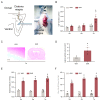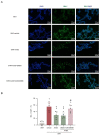Activation of the RARα Attenuated CSF Hypersecretion to Inhibit Hydrocephalus Development via Regulating the MAFB/MSR1 Pathway
- PMID: 36768908
- PMCID: PMC9917365
- DOI: 10.3390/ijms24032586
Activation of the RARα Attenuated CSF Hypersecretion to Inhibit Hydrocephalus Development via Regulating the MAFB/MSR1 Pathway
Abstract
Hydrocephalus has been observed in rats with spontaneous hypertension (SHRs). It has been demonstrated that activation of the oxidative stress related protein retinoic acid receptor alpha (RARα) has neuroprotective impacts. Our investigation aims to determine the potential role and mechanism of RARα in hydrocephalus. The RARα-specific agonist (Am80) and RARα inhibitor (AGN196996) were used to investigate the role of RARα in cerebrospinal fluid (CSF) secretion in the choroid plexus of SHRs. Evaluations of CSF secretion, ventricular volume, Western blotting, and immunofluorescent staining were performed. Hydrocephalus and CSF hypersecretion were identified in SHRs but not in Wistar-Kyoto rats, occurring at the age of 7 weeks. The RARα/MAFB/MSR1 pathway was also activated in SHRs. Therapy with Am80 beginning in week 5 decreased CSF hypersecretion, hydrocephalus development, and pathological changes in choroid plexus alterations by week 7. AGN196996 abolished the effect of Am80. In conclusion, activation of the RARα attenuated CSF hypersecretion to inhibit hydrocephalus development via regulating the MAFB/MSR1 pathway. RARα may act as a possible therapeutic target for hydrocephalus.
Keywords: CSF; MSR1; RARα; hydrocephalus; spontaneous hypertensive rat.
Conflict of interest statement
The authors declare no conflict of interest.
Figures





Similar articles
-
Spontaneously hypertensive rats can become hydrocephalic despite undisturbed secretion and drainage of cerebrospinal fluid.Fluids Barriers CNS. 2023 Jul 4;20(1):53. doi: 10.1186/s12987-023-00448-x. Fluids Barriers CNS. 2023. PMID: 37403103 Free PMC article.
-
Activation of RARα Receptor Attenuates Neuroinflammation After SAH via Promoting M1-to-M2 Phenotypic Polarization of Microglia and Regulating Mafb/Msr1/PI3K-Akt/NF-κB Pathway.Front Immunol. 2022 Feb 14;13:839796. doi: 10.3389/fimmu.2022.839796. eCollection 2022. Front Immunol. 2022. PMID: 35237277 Free PMC article.
-
NLRP3 inflammasome-mediated choroid plexus hypersecretion contributes to hydrocephalus after intraventricular hemorrhage via phosphorylated NKCC1 channels.J Neuroinflammation. 2022 Jun 21;19(1):163. doi: 10.1186/s12974-022-02530-x. J Neuroinflammation. 2022. PMID: 35729645 Free PMC article.
-
Cerebrospinal fluid hypersecretion in pediatric hydrocephalus.Neurosurg Focus. 2016 Nov;41(5):E10. doi: 10.3171/2016.8.FOCUS16278. Neurosurg Focus. 2016. PMID: 27798982 Review.
-
Targeting choroid plexus epithelium as a novel therapeutic strategy for hydrocephalus.J Neuroinflammation. 2022 Jun 17;19(1):156. doi: 10.1186/s12974-022-02500-3. J Neuroinflammation. 2022. PMID: 35715859 Free PMC article. Review.
Cited by
-
Mechanisms of cerebrospinal fluid and brain interstitial fluid production.Neurobiol Dis. 2023 Jul;183:106159. doi: 10.1016/j.nbd.2023.106159. Epub 2023 May 19. Neurobiol Dis. 2023. PMID: 37209923 Free PMC article. Review.
-
Spontaneously hypertensive rats can become hydrocephalic despite undisturbed secretion and drainage of cerebrospinal fluid.Fluids Barriers CNS. 2023 Jul 4;20(1):53. doi: 10.1186/s12987-023-00448-x. Fluids Barriers CNS. 2023. PMID: 37403103 Free PMC article.
References
-
- Kahle K., Kulkarni A., Limbrick D., Warf B., Jr. Hydrocephalus in children. Lancet. 2016;387:788–799. - PubMed
-
- McAllister J., Williams M., 2nd, Walker M., Kestle J., Relkin N., Anderson A., Gross P., Browd S. An update on research priorities in hydrocephalus: Overview of the third National Institutes of Health-sponsored symposium “Opportunities for Hydrocephalus Research: Pathways to Better Outcomes”. J. Neurosurg. 2015;123:1427–1438. doi: 10.3171/2014.12.JNS132352. - DOI - PubMed
-
- Leinonen V., Vanninen R., Rauramaa T. Cerebrospinal fluid circulation and hydrocephalus. Handb. Clin. Neurol. 2017;145:39–50. - PubMed
MeSH terms
Substances
LinkOut - more resources
Full Text Sources
Medical

